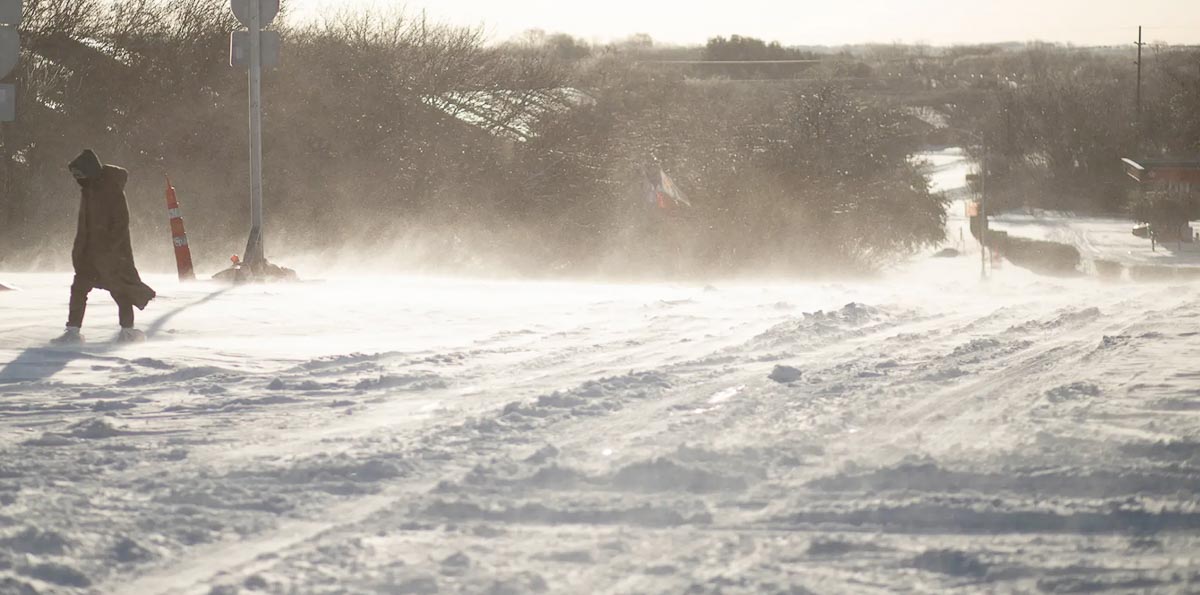Houstonians are putting their lives back together after February’s winter freeze. They’ve been fixing broken pipes, cutting back dead plants and waiting patiently for milk and meat quantities to return to normal levels at the grocery store.
As a newly minted Houstonian and disaster recovery researcher at the Kinder Institute, I have learned that residents of the Bayou City know full well how to prepare for hurricanes. But last month’s extremely cold weather brought prolonged power and water outages that were hard to predict. It was even more difficult to prepare for losing a sense of security that many of us felt several days in a row.
We huddled up with friends and family as hotels reached their occupancy or lost power. Many Houstonians weighed the benefit of sleeping in a warm house with people outside their household against the risk of contracting COVID-19. We are now living in a city with overlapping crises. Extreme weather events are becoming more frequent due to climate change, and the global pandemic is still moving through our community.
How can we better prepare for these types of converging crises?
The City of Houston’s resilience strategy, Resilient Houston, offers key information for improving disaster preparedness through several high-level targets. The Kinder Institute’s Resilience and Climate Progress in Houston webpage is helping to make information about the targets in Resilient Houston available along with those from Houston’s Climate Action Plan. Here are three ways that the city could help our community better prepare for the next pileup of disasters:
1. Make disaster preparedness resources available at COVID-19 vaccination appointments.
By 2025, the City of Houston has a target to provide at least half a million Houstonians with preparedness training. Currently, it has achieved 1% of its goal. The city needs to create integrated solutions that prepare residents for future disasters while also solving the crisis we are in now. For example, the Houston Health Department plans to vaccinate 126,000 people against COVID-19 by mid-March at its NRG Park vaccination site. Nurses could distribute disaster preparedness information (in all of the city’s official languages) to this group of patients after they receive their COVID-19 vaccine. This could include brochures about how to strengthen individual preparedness, such as by making a disaster plan and a disaster supplies kit.
Overall, this effort alone could increase the city’s progress toward its preparedness training target by 25%. Increased funding for an integrated solution like this could help Houstonians solve one crisis and quickly prepare for the next one while disaster preparedness is still on their minds.
2. Strengthen support for community preparedness through the city’s Resilience Ambassador Program.
A critical element of community preparedness is building the capacity of a community before an extreme event. In Houston, the city plans to develop a Resilience Ambassador Program for community leaders to connect neighbors so they can discuss any vulnerabilities they might have to disasters and ways to increase their collective resilience. Building social cohesion in this way will help to improve community preparedness because many neighbors will get to know and trust one another. The city should increase funding for this type of program because it will help to strengthen communities even before disasters strike.
3. Increase awareness of the city’s emergency alert system.
Another opportunity to improve disaster preparedness is to increase access to emergency alerts. By 2030, the city would like every Houstonian and visitor to have access to AlertHouston, an emergency alert system that provides disaster preparedness information based on location. Currently, 7% of Houstonians have registered. The city should increase awareness of its emergency notification system by stepping up its communications about how to register. This could include a robust strategy such as posting steps for registering on social media, putting sign-up information on billboards and digital signs next to freeways and displaying enrollment information on public transportation.
Now that the city has been implementing its Resilient Houston strategy for a full year, a more complete picture is emerging of the status of its resilience targets, as detailed in the city’s one-year report. The city is making progress on its targets, including those related to disaster preparedness, but more can be done. With more extreme weather events and disasters in our future, we need to change how our city prepares for these shocks and their long-lasting impacts so that Houstonians will take disaster preparedness more seriously.

